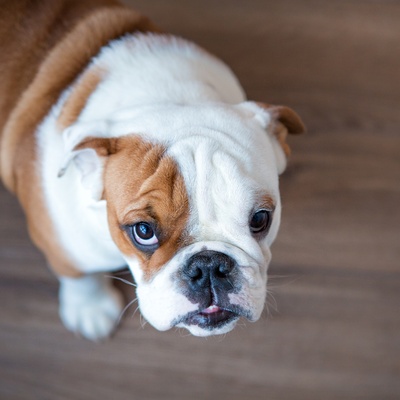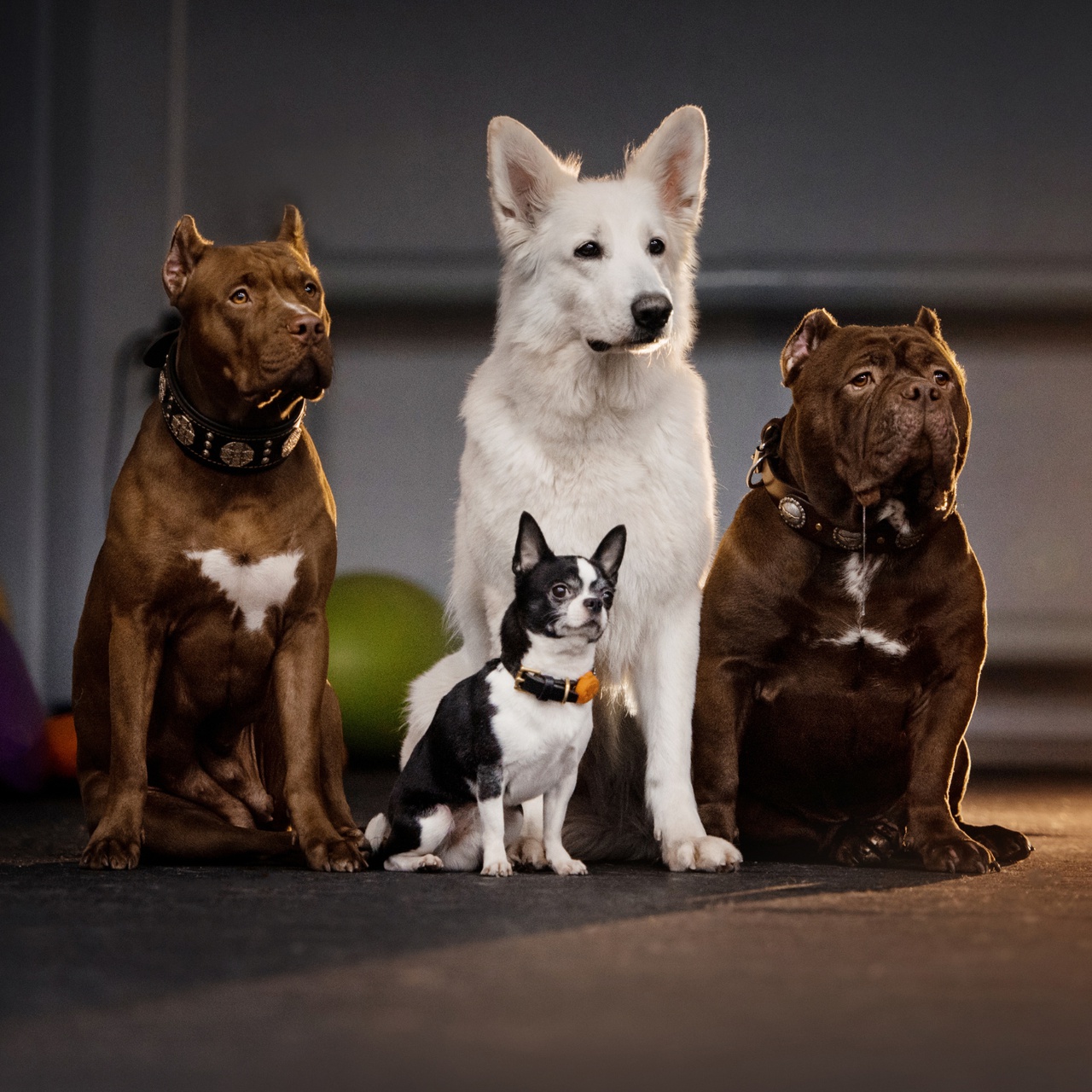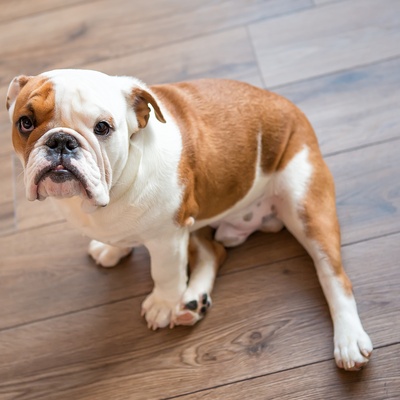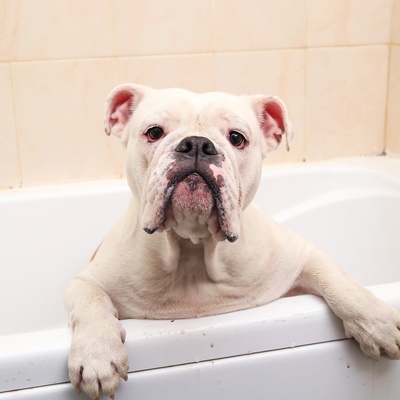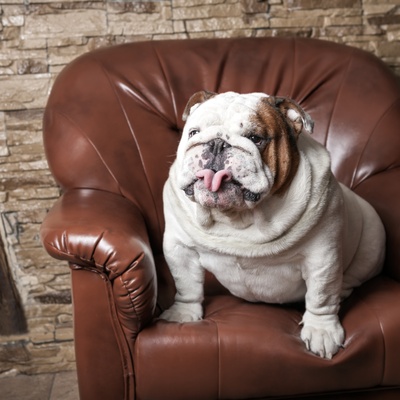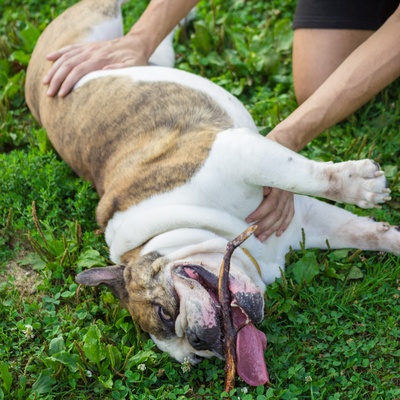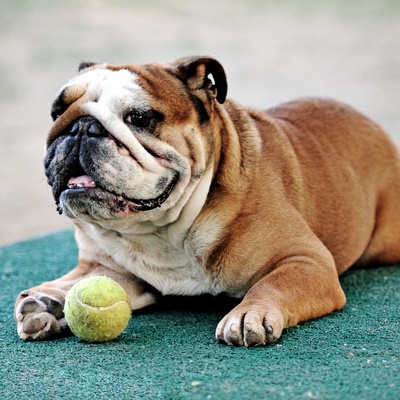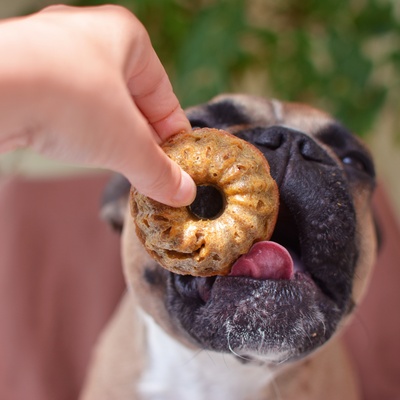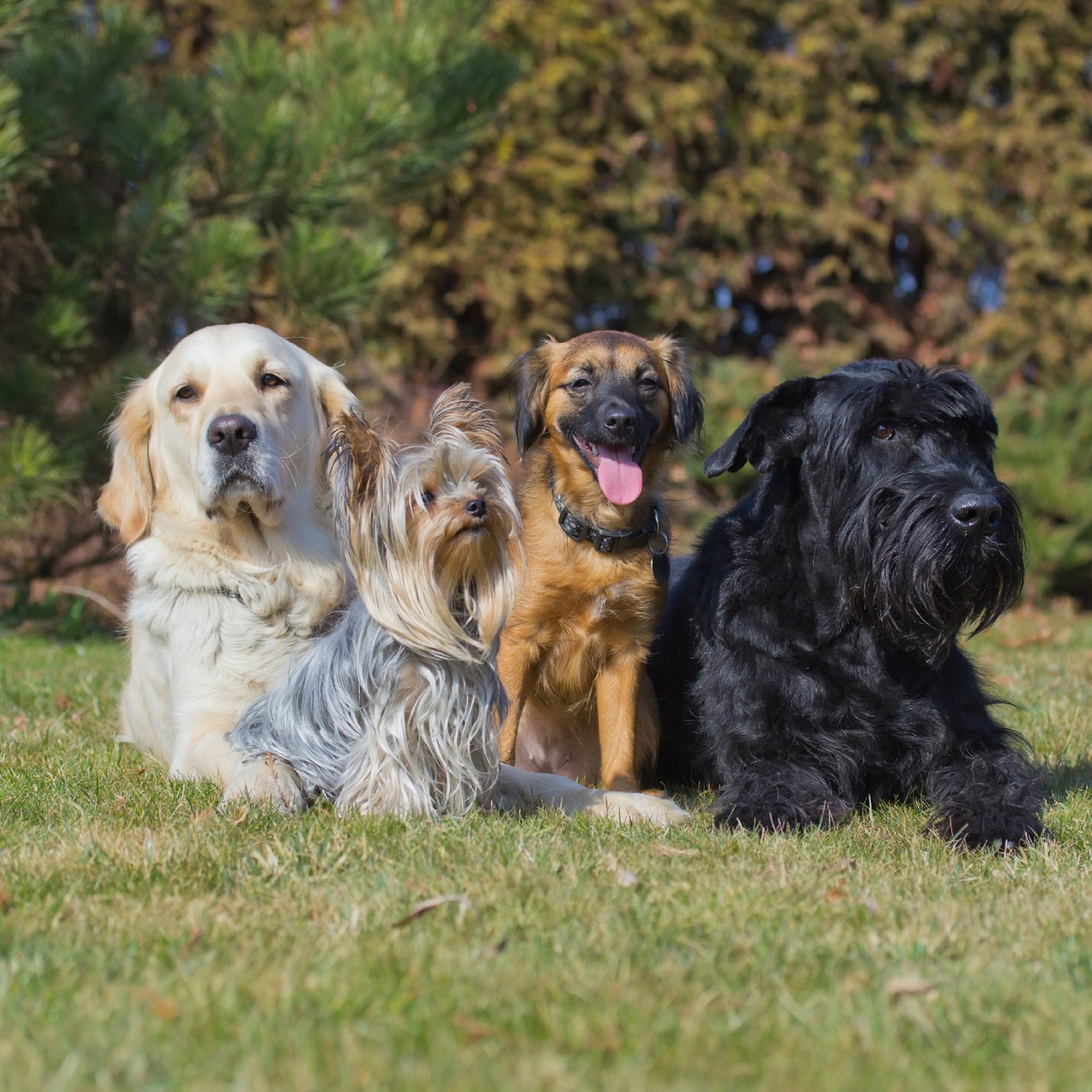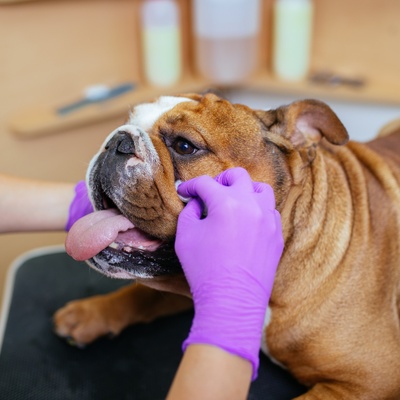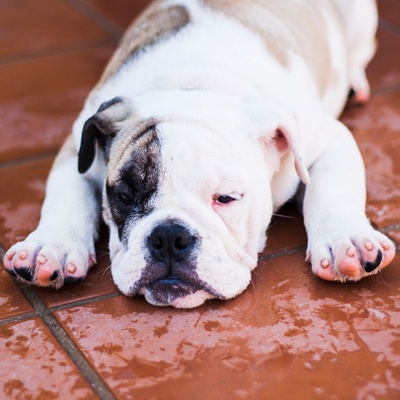Introducing the English Bulldog
Discover all there is to know about the English Bulldog: its characteristics, behavior, training, and its cost.

Discover all there is to know about the English Bulldog: its characteristics, behavior, training, and its cost.
The English Bulldog, with its unmistakable wrinkled face and stout stature, is an iconic breed that hails from Great Britain. Originally bred for the now-outlawed sport of bull-baiting, this breed has transformed into one of the most beloved family pets across the globe. Renowned for its courageous yet gentle demeanor, the English Bulldog is a true testament to how selective breeding can enhance the innate qualities of dogs.
English Bulldogs, historically linked to sports, are now beloved companions, known for loyalty and affection. Their sociable, patient nature makes them excellent family pets, especially with children. They display heartwarming affection and bring joy to their owners, embodying the essence of a lovable companion.
This section outlines the unique features of the English Bulldog breed.
The English Bulldog is a proud member of the group 2 known as the non-sporting group, characterized by diverse breeds that don’t fit the specific criteria of other groups, focusing on companionship and unique traits.
The English Bulldog is a medium-sized breed with a compact body, generally weighing between 40-50 pounds and standing about 14-15 inches at the shoulder.
English Bulldogs boast a short, straight, and fine coat, making their grooming needs manageable while also highlighting their muscular appearance.
Bulldogs come in a variety of colors, often brindle, white, red, fawn, or piebald, with patterns and markings that are uniquely their own.
English Bulldogs are well-suited for apartment living due to their moderate energy level, but they do appreciate a comfortable space where they can relax and stay cool.
Known for their friendly nature, English Bulldogs are generally amicable with children and other pets, making them excellent family dogs.
Bulldogs are generally robust but can be prone to certain health issues such as respiratory problems and hip dysplasia, a commonality in their breed.
With a reputation for being stubborn, the English Bulldog requires consistent, patient training, but their desire to please can make this process rewarding.
We can help!
Every dog has its own character, and so do you. Making the right choice will ensure his well-being and yours.
Take our quiz to find out which breed is right for you, based on your personality, lifestyle, location and many other criteria.
Don't wait any longer and take the quiz to find out the answer!
The English Bulldog is robust and muscular with a distinctive waddle. Their coat, often brindle or piebald, complements their amiable yet somewhat gruff expression.
English Bulldogs are compact and powerful dogs. Females typically stand between 12 to 14 inches, while males reach up to 16 inches.
In terms of weight, females usually range from 40 to 50 pounds, with males tipping the scales at 50 to 55 pounds.
English Bulldogs develop at a moderate pace. Puppies may reach half their adult weight by four to five months of age. They tend to reach their full size and weight by the age of 12 to 18 months.
The English Bulldog sports a short, straight, and fine coat, which clings tightly to the body. The texture is smooth and glossy, highlighting the dog's muscular frame without the presence of fringes or waves.
The coat of an English Bulldog exhibits a beautiful variety of patterns and shades. Standard colors include brindle, piebald, fawn, and white, often combined in patches or other markings that give each Bulldog a distinctive appearance.
The English Bulldog's coat may be low-maintenance due to its length, but it requires regular care to maintain its condition. This breed sheds moderately throughout the year, which can be managed with weekly brushing. It's essential to clean their folds of skin regularly to prevent irritation and infection. Grooming is not only a time for cleaning but also for inspecting the dog's skin for issues and enhancing the bond between pet and owner.
The English Bulldog is the epitome of a balanced and well-proportioned canine, with a distinctive, commanding presence. The breed boasts a broad, square head with cheeks that extend to the sides of the eyes, and a pronounced dewlap that hangs down from the neck. The eyes of an English Bulldog are round, set low in the skull and far apart, typically dark in color with a gaze that is both pensive and alert. Their small, thin ears are known as 'rose ears', set high on the head and folding inwards. Their body is compact and muscular, with a sturdy, hefty frame that belies their medium size.
English Bulldogs are renowned for their steadfast loyalty and affectionate nature, often forming strong, protective bonds with their families.
With well over 400 recognized dog breeds categorized into 7 primary groups, each cluster reflects shared traits and ancestral functions.
The English Bulldog is a prominent member of the Group 2, a diverse collection that ranges from the Dalmatian to the Chow Chow. Breeds within this group are cherished for their unique qualities and varied roles rather than a specific working trait. Their temperaments and skills are as diverse as their appearances, making them a fascinating and eclectic group.
The English Bulldog, with its calm demeanor and amiable nature, stands out as a companion dog. Its role has evolved from a participant in the brutal sport of bull-baiting to a gentle, friendly breed whose primary job is to be a loving pet. Despite their formidable ancestry, Bulldogs are recognized for their gentle disposition and undying loyalty, making them beloved pets and gentle family members.
The English Bulldog exhibits a dignified demeanor, often appearing as the quintessence of calmness and resilience. Their behavior is characterized by a steady, predictable nature, and they display their affection with a quiet but unmistakable loyalty.
Bulldogs form deep bonds with their owners, thriving on companionship and regular interaction. For their psychological well-being and behavioral development, the presence of an attentive owner is paramount. They might not be as demonstrative as some breeds, but their devotion is unwavering, making them a dependable member of the family.
English Bulldogs are known for their sociable and amiable spirit, often showing a genial generosity towards humans and other pets alike. Their stout hearts match their robust appearances, fostering friendships with ease when socialized properly. While they maintain a kind disposition, Bulldogs can be somewhat reserved, making their acceptance of new individuals a true sign of trust. They are generally good with children, exhibiting patience and a protective instinct, which make them excellent family pets.
It's crucial, however, to cultivate their social skills early on to ensure they grow into well-adjusted adults, comfortable in a variety of settings and scenarios.
The English Bulldog is remarkably versatile, capable of thriving in diverse living environments, from the compact spaces of city apartments to the sprawling expanses of suburban or rural homes. Their moderate energy levels make them well-suited to various lifestyles, provided they receive consistent affection and attention from their owners.
Bulldogs benefit from daily walks, which should be kept relatively short, typically around 15 to 20 minutes each, to accommodate their brachycephalic nature and to prevent overexertion.
While the English Bulldog appreciates a good amble and the occasional playful frolic, they are predominantly indoor creatures. Their adaptability is high, yet they do have a penchant for comfort and are happiest in environments where they can lounge near their owners. An accessible outdoor space can be beneficial for them to explore and sniff around, satisfying their mild curiosity and helping to keep their muscles toned.
However, this should be a secure area, as Bulldogs can be surprisingly tenacious when something catches their interest.
Training an English Bulldog can be a unique experience due to their distinct personality. They are intelligent dogs with an independent streak that sometimes gets mistaken for a lack of intelligence. Patience and consistency are key in their training, as they can be quite stubborn.
Positive reinforcement techniques work best, rewarding good behavior with treats and praise. Early socialization and obedience training are recommended to shape a well-mannered adult Bulldog. Due to their explorative nature and tendency to wander in pursuit of an interesting scent, equipping them with a GPS collar is a wise precaution to ensure their safety and prevent any unexpected escapades.
Despite their sometimes obstinate demeanor, English Bulldogs are sensitive to their owner's tone of voice and are eager to please once engaged. They respond well to firm yet gentle commands and benefit from a consistent training routine.
Uniquely, Bulldogs often exhibit a clownish behavior to distract from training, so it's important for the owner to be patient and maintain a sense of humor. They may not be the fastest learners, but with the right approach, they can be taught a variety of commands and behaviors. Due to their friendly nature, they typically do not require intensive guard dog training but can be reliable watchdogs when properly trained to discern normal from suspicious activities.
Take the test and find out the dog breed that matches your personality and lifestyle.
English Bulldogs need careful attention due to their brachycephalic nature and skin folds that can lead to respiratory issues and infections. Regular cleaning and vigilant care are crucial for their health.
The robust appearance of the English Bulldog may be deceiving, as they are not as hardy as they look. This breed commonly grapples with health issues such as respiratory problems due to their shortened airways, hip dysplasia, skin infections within their wrinkles, and eye conditions like cherry eye.
They can also suffer from heart conditions and are particularly susceptible to overheating. Symptoms vary from labored breathing and lethargy to skin irritation and limping. It is crucial for Bulldog owners to be vigilant and responsive to these potential health concerns. On average, an English Bulldog's lifespan ranges from 8 to 10 years.
Regular vet visits are essential for the English Bulldog to receive timely vaccinations, worming treatments, and to manage parasites. Daily care includes gently cleaning their facial wrinkles to prevent infection, regular ear cleaning to avoid buildup that can lead to infections, and dental care to prevent periodontal disease. Their nails should be trimmed regularly to prevent discomfort and walking issues.
Bulldogs are also known to have sensitive stomachs, so being observant for any signs of food allergies is important, and discussing these with a vet can lead to a tailored diet plan. Unfortunately, the English Bulldog is not considered hypoallergenic due to its moderate shedding.
English Bulldogs have distinct nutritional needs that must be met to maintain their unique physique and support their overall health. A balanced diet is crucial for sustaining their energy levels and preventing the numerous health issues to which the breed is predisposed. Ensuring a high-protein, vitamin-rich diet is vital for their wellbeing. High-quality kibble, specifically formulated for English Bulldogs, can provide this balanced diet, catering to their slower metabolism and helping to manage their weight.
If your Bulldog is particularly active or requires additional protein, incorporating lean meats such as chicken or beef is beneficial, but it's essential to keep fat content low to avoid pancreatitis and obesity. Remember, Bulldogs can be voracious eaters, so it's critical to establish and adhere to a feeding schedule to prevent overeating and maintain optimal digestive health.
There is a robust network of breeders, but with such popularity comes the responsibility to choose wisely. It's important to consider several factors before adopting, including the cost of acquisition and ongoing care.
Adopting an English Bulldog requires thoughtful consideration to ensure you're making an informed decision. A reputable breeder is paramount; you'll want to visit the breeding facility to observe the conditions and demeanor of the dogs on-site. The health of the puppy and its parents is crucial, so transparency regarding their medical history is non-negotiable.
Lastly, mandatory electronic identification, like microchipping, is not always mandated at the federal level in the United States for cats and dogs. But microchipping is widely acknowledged as a successful way to permanently identify pets and increase the possibility of reuniting lost pets with their owners, even in the absence of universal regulations.
As a pet owner, it is advised to inform yourself about municipal laws to ensure the safety and wellbeing of your pet.
The initial cost for an English Bulldog puppy can vary significantly, influenced by factors such as the dog's lineage, the pedigree, the breeder's reputation, and the age of the dog. Typically, you might expect to pay anywhere from
to
for a well-bred English Bulldog puppy.
It's essential to consider that owning an English Bulldog will incur ongoing expenses, such as high-quality food, potential medical costs due to common health issues, and general maintenance. The estimated annual cost for maintaining an English Bulldog is approximately
to
, varying with the dog's needs and unforeseen expenses.
Choosing a dog that matches your personality and lifestyle will ensure your well-being and his!
